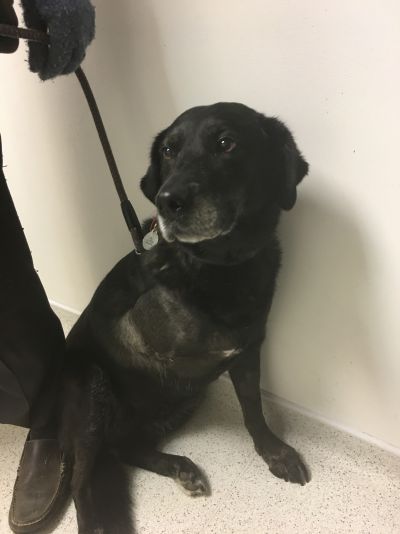
Posted By:
Amputation of a limb isn’t an option that owners want to have to consider for their dogs, but sometimes unfortunately some diseases leave owners and vets with little option. When it comes between losing a leg or extending life, this often helps owners come to a decision on the surgery, whilst it is also worth noting that a lot of dogs can cope very well on three limbs. This is the case with Jenny, who impressed us all with her amputation recovery following the diagnosis of a malignant tumour.
Jenny is a rescued Labrador cross who had been limping for a little while. Because she came from a rescue centre, there was not a definite age for her, but she was confirmed at being at least 10 years old, and probably older. Jenny was limping on her front right leg, and in the absence of any other symptoms initially, she was presumed to be struggling with osteoarthritis. This condition is very common in older Labradors, and they particularly suffer with arthritis in their elbow joints.
Jenny was prescribed some anti inflammatory pain killer medication at the vets and responded pretty well, with her limp more or less disappearing. After a couple of weeks without medication, her limp returned, but most importantly a lump was seen on her lower leg. Jenny returned to the practice, and it was clear that there was a firm, bony, painful swelling on the outside of her leg just above the wrist joint. At this point it was feared that Jenny was suffering from something more than arthritis, and a bony tumour was definitely a suspicion given its appearance and location. Certain types of bone tumours tend to be more likely at the wrist, shoulder or knee.
That day Jenny was admitted for an X-ray under sedation to investigate her bony swelling further. Once the X-ray was taken, the radiograph picture seemed to confirm the suspicion of a tumour. Bone tumours tend to destroy normal bone tissue, so the appearance of a ‘fluffy cloud’ type area where solid bone should be is usually a tell tale sign. The type of bone tumour suspected was a malignant cancer, and so expected to behave aggressively, spreading to other parts of the body, particularly the lungs. Jenny’s chest was X-rayed and this fortunately showed no evidence of secondary cancer spread. With consent from Jenny’s owners, the swelling was then sampled with a large needle, in order to achieve a small biopsy, or fine needle aspirate, that could be sent to the lab for confirmation of tumour type.
The next day, unfortunately the worst suspicions were confirmed with the diagnosis of an osteosarcoma, a malignant bone cancer. Once the bad news was broken to her owners, a treatment plan was needed for Jenny. Potentially surgery could be performed to remove the lump without removing the leg, but this would be a huge, invasive procedure which would not guarantee to extend her life. Removing the leg by an amputation surgery was an ‘easier’ procedure, and could prolong her life for a fair while, but unfortunately was unlikely to be a full cure either. Leaving the lump was an option, but Jenny would have to have her pain controlled as much as possible, and her life expectancy may only be a couple of months. Jenny’s owners had a difficult decision to make.
After some thinking time, Jenny was booked in for an amputation of her right front leg the following week. Jenny was anaesthetised and once a further, more detailed inflated X-ray view of her chest was taken and also confirmed no sign of spread, she was taken to theatre to proceed with her surgery. Although simpler than removing the lump whilst trying to keep the leg, the removal of a limb is still a tricky procedure, especially in a big dog like Jenny. There are many big blood vessels, muscles and nerves that need to be delicately cut through without causing too much damage or blood loss, and of course a large bone which needs to be surgically sawed through. Eventually though, the procedure was a success and her skin was stitched up as neatly as possible.
Jenny’s pain was managed as well as possible post-operatively, and initially she was understandably very drowsy. However, after only a few hours, Jenny surprised us all by really turning a corner, eating well and managing to go for a walk around the practice – relatively effortlessly! Jenny’s owners were delighted to be informed of this and arrived that evening to collect her from the practice. Jenny hopped over to them at once, wagging and bright. Because of her age, Jenny probably did have a degree of arthritis in her other elbow, and now this leg would take on further strain. She was discharged with her continuing pain relief medication, and this would probably be continued for life to keep her pain free. It was also important that Jenny was kept as lean as possible and was exercised appropriately.
At home, Jenny was recovering amazingly well and managed to rise above it all, like nothing had ever happened! Her wound was healing well and she managed to impress everyone with how well she was coping on three legs – now we all hoped that the procedure would give her some nice, extended quality time that she deserved.
Whilst on my visits I have been having several discussions...
As our feline friends get older there are a few conditions...
Another winter discussion group season is now behind...
©2024 Shepton Veterinary Group Ltd., All rights reserved.
Privacy Policy • Terms & Conditions • Cookie Policy